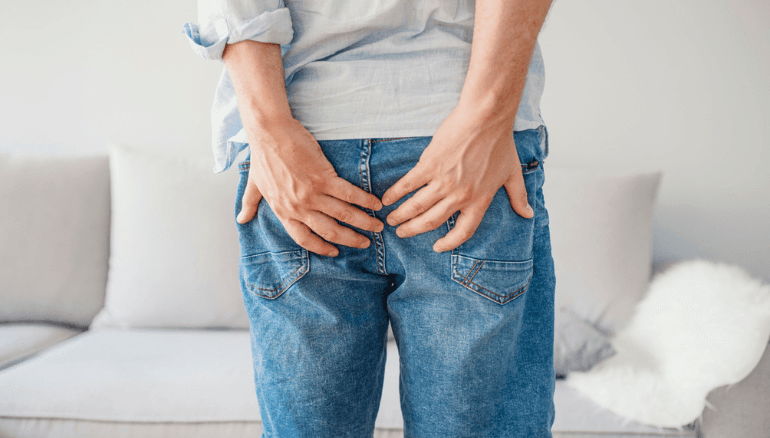Prostate health often isn’t thought about (let alone managed) until there’s a problem with it. And most men will eventually have a prostate problem. Prostate cancer is the most common cancer diagnosed in Australian men, benign prostatic hyperplasia (BPH) impacts half of men over 50 and prostatitis affects 15% of blokes at some point in their lives. So, it’s important to understand how you can help prevent these conditions and put yourself in the best position to treat them.
Here’s what you need to know about prostate health and how you can improve your prostate health.
What is your prostate?
Don’t know what the prostate is or what it does? You’re certainly not alone.
So a quick refresher — your prostate is a gland about the size of a walnut that sits around the urethra (the tube that passes urine and semen out of the body). The prostate gland is part of the male reproductive system, and it produces a fluid that, together with sperm cells, makes up semen. The fluid helps to protect and transport sperm in the female reproductive system.
Common prostate problems
There are three main conditions that affect the prostate.
1. Benign prostatic hyperplasia
As men age, benign prostatic hyperplasia (BPH) can cause prostate enlargement. About 50% of all men aged over 50 have BPH, increasing to over 80% for men aged 80 or older. On its own, BPH isn’t anything to worry about, but its symptoms (such as changes in the strength of your urine stream, trouble starting or finishing urination and needing to urinate more or less frequently than usual) can cause considerable discomfort, inconvenience and reduced quality of life.
You can read more about prostate enlargement here.
2. Prostatitis
Prostatitis is inflammation of the prostate gland and it’s a common cause of pelvic pain in men.
The symptoms and treatment for prostatitis depend on the type. You can read more about prostatitis here.
3. Prostate cancer
Your risk of developing prostate cancer increases as you get older and is higher if you have a family history of the disease. One in six men will develop prostate cancer by the age of 85. Some racial and ethnic groups have a greater risk of prostate cancer than others. Prostate cancer doesn’t usually cause symptoms, especially in the early stages of the disease.
You can read more about prostate cancer here.
How to look after your prostate
There are factors that contribute to prostate problems that you can’t control, like your genetics or age. But there are some things in your power when it comes to prostate health and they’re the basics of overall wellbeing.
1. Maintain a healthy body weight
Researchers are continuously looking at ways to prevent and treat prostate disease and the evidence for some ideas is more conclusive than others. The link between your weight and prostate problems is a strong one.
If you’re having a hard time maintaining a healthy weight, chat with your doctor, who can work with you and other health professionals to help find solutions.
2. Exercise regularly
Research consistently shows exercise can help prevent or treat disease and chronic health conditions, including prostate problems. Men who are more physically active are less like to experience BPH and men with prostate cancer who do a modest amount of vigorous activity each week are 61% less likely to die from the disease after diagnosis[3].
“When we exercise our muscles produce medicine — substances that are called cytokines — and they actually suppress tumour cell growth.”
– Robert Newton, Professor of Exercise Medicine at Edith Cowan University
“We see that exercise also activates the immune system and, in particular, what are called natural killer cells. When we exercise, these natural killer cells circulate into the cancer, they attack the cancer cells and it’s through those mechanisms, we’re starting to understand how exercise actually slows cancer progression.”
Chronic prostatitis or chronic pelvic pain syndrome can be difficult to treat but physical therapy and exercise may help manage the condition[4].
3. Eat a healthy diet
You might have seen headlines promoting the benefits of eating tomatoes for prostate health or that higher consumption of dairy products increases your risk of developing prostate cancer. But before you stock your shelves with pasta sauce or bin the yogurt — the evidence on the benefits or dangers of specific foods or the nutrients within them is limited and not conclusive. Your best bet is to aim for an overall pattern of healthy eating.
“The principles of healthy eating apply to good prostate health,” says Accredited Practising Dietitian, Joel Feren. “Ensuring you meet your core food targets [for] fruit, vegetables, whole grains, dairy, meat, and plant-based alternatives, is vital.”
Men are also more likely to have BPH if they eat a diet that’s low in fruit, vegetables, and legumes.
“The don’ts include excessive alcohol consumption and eating too much processed meat, sweet biscuits, chips, etc,” Feren says. “Some research shows that soy foods can promote good prostate health,” Feren added.
“Observational studies have found that men with a high intake of soy milk, tofu and tempeh have a reduced incidence of prostate cancer. It’s a big tick for a nutritious food that over the years has been unfairly labelled bad for blokes .”
The benefit of making these changes? They’re good for all parts of your health, not just your prostate.










